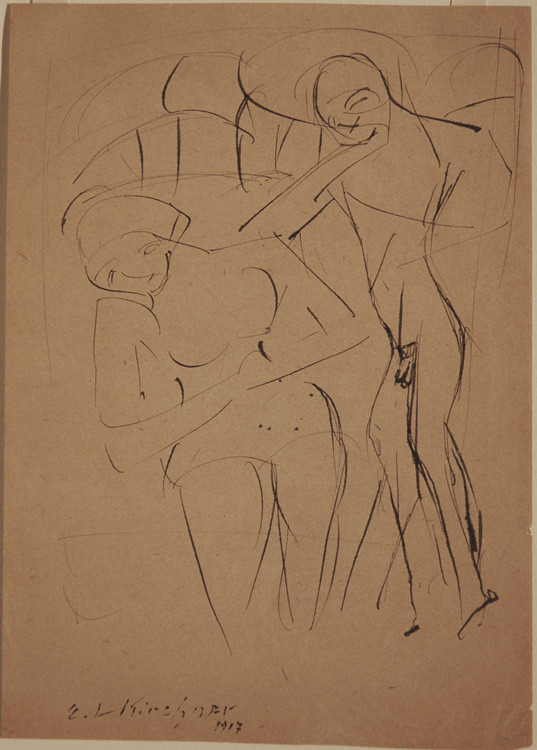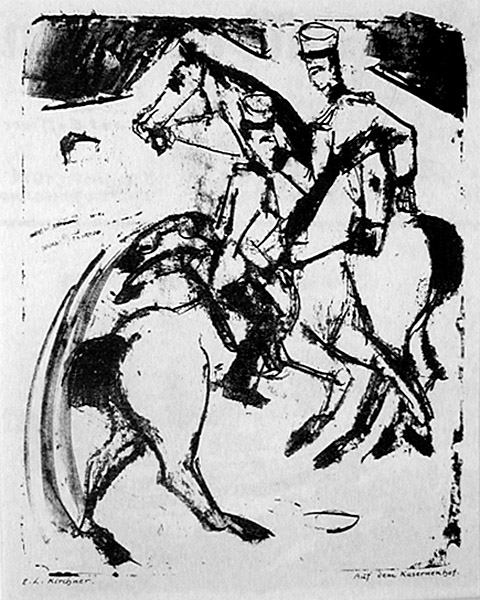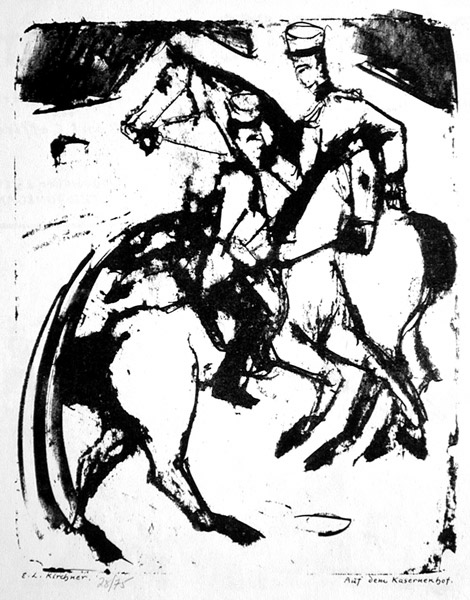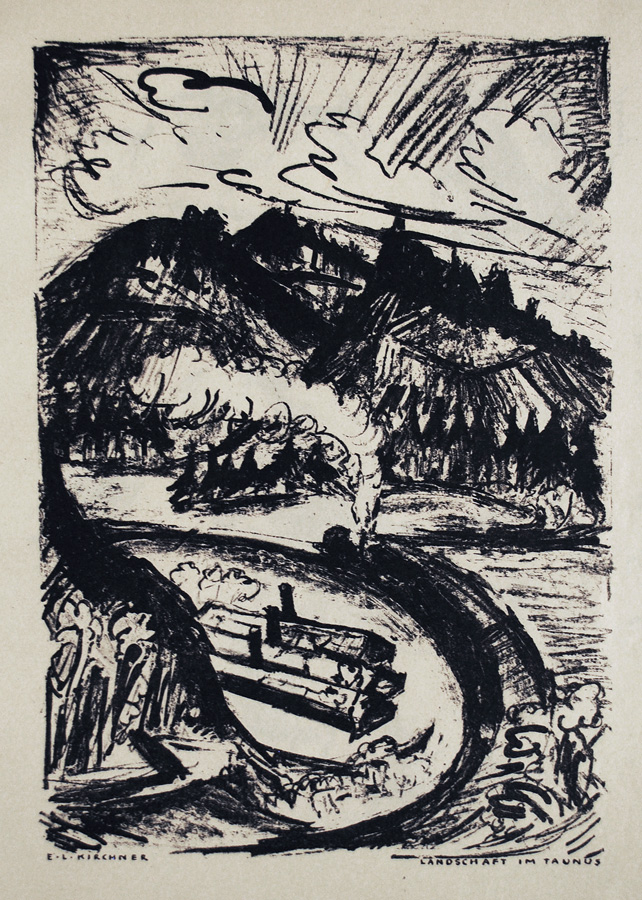Click image for BBB rating
See our Privacy Policy
cool="cool" width="784" height="5203" border="0" cellpadding="0" cellspacing="0" gridx="16" showgridx="showgridx" usegridx="usegridx" gridy="16" showgridy="showgridy" usegridy="usegridy" bgcolor="#99ccff">
|
|
|
 |
|
|
|
|
|
|
Welcome to Spaightwood Galleries, Inc.
120 Main Street, Upton MA 01568-6193
Ernst Ludwig Kirchner (German, 1880-1938): Original Lithographs and a Drawing
|
|
|
|
|
One of the most important artists of German Expressionism, Kirchner was a founding member of Die Brucke in 1905 (along with Erich Heckel, Karl Schmidt-Rottluff, and Fritz Bleyl; they were soon joined by Emile Nolde and Max Pechstein) and its dominant member for the next five or six years until his criticisms of his fellows alienated him from them and the group dissolved in 1913. In 1910 he settled in Berlin and began a series of paintings based upon the streets of Berlin combining cityscapes and figures. He was drafted in 1915 but suffered a nervous breakdown and was released in 1916. After being hit by a car in Berlin, he underwent a long period of recovery, leaving Berlin and settling in Switzerland. Although there were many retrospectives of his work in Germany during the 1930s, he suffered a crisis after the Nazis included his works in the 1937 Degenerate Art Exhibition. He shot himself the following year. In The Oxford Dictionary of 20th-Century Art, Ian Chilvers ranks Kirchner as "one of the 20th century's greatest masters" of printmaking, and says that his mature works are distinguished by "a harsh contrast of planes and abrupt angularity influenced by his admiration for medieval German woodcuts" (p. 318). The last 40 years have seen a tremendous critical interest in Kirchner's prints and paintings; his works are to be found in every important museum in Europe and America.
Select Bibliography:
Annemarie Dube-Heynig, Kirchner: His Graphic Art (Greenwich CT: New York Graphic Society, n.d. [1961]); Karlheinz Gabler, E. L. Kirchner Zeichnungen, Pastelle, Aquarelle (Aschaffenburg: Museum der Stadt Aschaffenburg, 1980); Gretchen Gercken, Ernst Ludwig Kirchner, Holzschnittzyklen (Stuttgart: Belser Verlag, 1980); Günther Gercken, E. L. Kirchner Zeichnungen und Druckgraphk 1905-1936 (Hamburg: Kunstverein in Hamburg, 1978); Lucius Grisebach, Annette Meyer zu Eissen, Ulrich Luckhardt, E. L. Kirchner 1880-1938;Ausst.Katalog Nationalgalerie Berlin 1979 (Berlin: Nationalgalerie Berlin, 1979); Donald E. Gordon, Ernst Ludwig Kirchner: A Retrospective Exhibition (Boston: Museum of Fine Arts, 1968); Lucius Grisebach, Ernst Ludwig Kirchner 1880-1938 (Cologne: Taschen, 1999); Will Grohmann, E. L. Kirchner, trans. Ilse Falke (NY: Arts, Inc. 1961); Florien Karsch, E. L. Kirchner Aquarelle, Pastelle, Handzeichnungen (Berlin: Galerie Meta Nierendorf, 1961); Roman Norbert Ketterer and Claus Zoege von Manteuffel, Ernst Ludwig Kirchner: Drawings and Pastels (NY: Alpine Fine Arts Collection, 1982); Kirchner Museum, Davos & Museum Folkwang, Essen, Ernst Ludwig Kirchner. Das Innere Bild. "Farben sind die Freude des Lebens." Exhibition: 1999-2000 (Cologne: Dumont, 1999); Ernst Ludwig Kirchner, Zeichnungen, Druckgraphik. Ausstellung zum 100. Geburtstag am 6.Mai-29.J uni 1980 (Bremen: Graphisches Kabinett, Kunsthandel Wolfgang Werner KG, 1980); Ernst Ludwig Kirchner in der Graphischen Sammlung der Staatsgalerie Stuttgart (Stuttgart: Staatsgalerie Stuttgart, 1980); Ernst Ludwig Kirchner, Zeichnungen 1906-1925 (Kassel: Staatliche Kunstsammlungen Kassel, 1967); Christian Lenz, E. L. Kirchner. Aquarelle, Zeichnungen und ausgewählte Druckgraphik (Frankfurt: Städelsches Kunstinstitut, 1974); Christian Lenz, et al, Ernst Ludwig Kirchner: Aquarelle, Zeichnungen, und Druckgraphik (Frankfurt: Stedel, 1980); Jill Lloyd, Magdalenea M. Moeller, Andrew Robison, and Norman Rosenthal, Ernst Ludwig Kirchner1880-1938 (Washington D.C.:National Gallery of Art, 2003); Jill Lloyd and Magdalenea M. Moeller, ed. Ernst Ludwig Kirchner: The Dresden and Berlin Years (London: Royal Academy of Arts, 2003); Magdalena Moeller, Ernst Ludwig Kirchner: Meisterwerke der Druckgraphik (Berlin: Brucke Museum, 1990); Helen Serger, Max Pechstein: Brücke Period and works by Nolde, Kirchner, and Schmidt-Rotluff (NY: Helen Serger/La Boetie, 1984); Margrit Suter-Lang, ed. E. L. Kirchner und Rot-Blau (Basel: Kunsthalle Basel, 1967); W. R. Valentiner, E. L. Kirchner, German Expressionist (Raleigh: The North Carolina Museum of Art, 1958); Deborah Wye, Kirchner and the Berlin Street (NY: MoMA, 2008).
|
|
|
|
|
 |
|
|
|
Akt und sitzenden Weib / Nude and sitting woman. Pen and ink onlight tan paper, 1917. Signed and dated 1917 in ink lower left. For other examples of Kirchner's signature on ink drawings see, for example, Karlheinz Gabler, E. L. Kirchner Zeichnungen, Pastelle, Aquarelle (Aschaffenburg: Museum der Stadt Aschaffenburg, 1980), p. 129; for similar compostions, see Couple in the Studio, plate 20, Jill Lloyd, Magdalenea M. Moeller, Andrew Robison, and Norman Rosenthal, Ernst Ludwig Kirchner1880-1938 (National Gallery of Art, 2003). Image size: 190x135mm. Price: Please call or email for current pricing information.
|
|
|
|
|
|
|
Roman Norbert Ketterer's commentary upon Bathers in a Tub, a 1914 Kirchner drawing, seems very much to the point in suggesting a way of approaching our drawing of a standing male nude approaching a seated female, so I quote at some length: "In these quickly drawn scenes, in which an instantaneous impression was captured often in a matter of only a few minutes, a moment is represented. Much is superfluous and insignificant or implies something that was not actually seen. Kirchner is trying out a drawing style. The figures and their progressive movements are described differently than before. The lines are thin and long. They do not describe specific parts of the body but rather enclose the figures within a relatively common contour. . . . The lines cross, touch and move apart but nevertheless describe limbs. They serve simultaneously as contours which form the figure and enclose it within a geometric shape, and extend beyond the description of pure physicality or the pure outline of the body to merge with other linear configurations. It was only in 1914 that Kirchner began to employ this compositional achievement. The linear system in which the outline of a body is simultaneously a compositional contour continuously takes up the linear system which is imposed upon the entire drawing. It seems as though a carefully ordered framework has been superimposed on the entire drawing. The figures are elongated and attenuated, almost Mannerist in feeling" (in Roman Norbert Ketterer and Claus Zoege von Manteuffel, Ernst Ludwig Kirchner: Drawings and Pastels (NY: Alpine Fine Arts Collection, 1982), pages 118-19). From the fall of 1913 to 1915, when the final painting in the series was completed, Kirchner had been obsessed with his paintings, drawings, and prints of the Berlin Street Scene and of the prostitutes who met their customers before taking them off to their rooms. Also in 1915, Kirchner enlisted in the German Army and became an ambulance driver for an artillery regiment, but soon was diagnosed with a debilitating nervous condition and spent time in several sanitariums. He was discharged as unfit for service and, in 1916, he was rehospitalized for treatment in Germany. In 1917, he traveled to Davos, Switzerland for treatment and made it his permanent residence for the rest of his life. Our drawing may mark a moment in which he is revisiting the period immediately before his breakdown as a way of trying to recapture the creative energy of that period before he went to war. For the Berlin Street Scenes, see the catalogue of the recent spectacular show at the Museum of Modern Art by Deborah Wye listed above; it is from this that I have taken the chronology above (see pages 129-30).
|
|
 |
|
|
In the barracks' courtyard (Davis-Rifkind 1462, Dube 308 II C). Original lithograph, 1916. Published in Der Bildermann (1916), a German art periodical that commissioned and published original lithographs by a number of Expressionist artists including Barlach, Heckel, and Kokoschka. Signed in the stone. Image size: 268x214mm. Price: SOLD.
|
|
|
|
|
|
 |
|
In the barracks' courtyard (Davis-Rifkind 1462, Dube 308 C). Original lithograph, 1916. Published in the deluxe edition of 75 numbered exemplars on Butten paper for Der Bildermann (1916), a German art periodical that commissioned and published original lithographs. Signed in the stone and numbered in pencil 28/75 . Image size: 268x214mm. Price: Please call or email for current pricing information.
The color of the paper should be more like that of the Landschaft im Taunus below.
|
|
|
|
 |
|
Bildniss Carl Sternheims / Portrait of Carl Sternheim (Davis-Rifkind 1464, Dube 328 C). Original lithograph, 1916. Published in a deluxe edition of 75 numbered exemplars on Butten paper for Der Bildermann (1916), a German art periodical that commissioned and published original lithographs. One of the greatest portraits of German Expressionism. Image size: 300x202mm. Price: SOLD.
We also have another impression from the regular edition from Der Bildermann (1916). Image size: 300x202mm. Price: SOLD.
|
|
|
|
 |
|
Landschaft im Taunus (Davis-Rifkind 1468, Dube 315 C). Original lithograph, 1916. Published in the regular edition of Der Bildermann (1916), a German art periodical that commissioned and published original lithographs. Signed in the stone lower left. Image size: 280x198mm. Price: Please call or email for current pricing information.
There was also a deluxe edition of 75 numbered in pencil published in the deluxe edition of Der Bildermann (1916). Price: SOLD
|
|
|
|
|
Spaightwood Galleries, Inc.
To purchase, call us at 1-800-809-3343 (1-508-529-2511 in Upton MA & vicinity) or send an email to spaightwood@gmail.com
We accept AmericanExpress, DiscoverCard, MasterCard, and Visa.
We also accept wire transfers and paypal.
For directions and visiting information, please call. We are, of course, always available over the web and by telephone (see above for contact information). Click the following for links to past shows and artists. For a visual tour of the gallery, please click here. For information about Andy Weiner and Sonja Hansard-Weiner, please click here. For a list of special offers currently available, see Specials.
All works are sold with an unconditional guarantee of authenticity (as described in our website listing).
Copyright 2004-2017, Spaightwood Galleries, Inc.
Go back to the top of this page.
Visiting hours: Saturday 10:00 am to 5:00 pm and Sunday noon to 6:00 pm and other times by arrangement.
Please call to confirm your visit. Browsers and guests are welcome.
|
|
|
|
|
|
|
|
|
|
|
|
|
|
|
|
|
|
|
|
|
|
|
|
|
|
|




